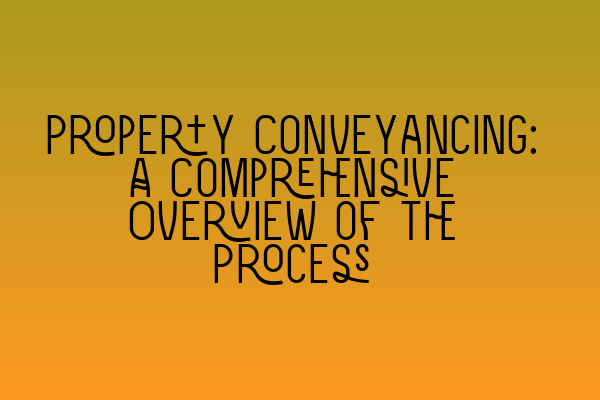Property Conveyancing: A Comprehensive Overview of the Process
Welcome to SQE Property Law & Land Law! As solicitors specializing in property law, we understand that the conveyancing process can be complex and overwhelming for many individuals. Whether you are buying or selling a property, it is crucial to have a firm understanding of the conveyancing process to ensure a smooth and successful transaction. In this comprehensive overview, we will take you through the key steps involved in property conveyancing and provide you with valuable insights along the way.
Before we delve into the nitty-gritty details, let’s first clarify what property conveyancing is. Conveyancing refers to the legal process of transferring the ownership of a property from one party to another. It involves a series of steps that need to be completed to ensure that the property is legally and properly transferred. The process typically involves the involvement of solicitors or licensed conveyancers who act on behalf of the buyer and seller.
Now, let’s break down the conveyancing process into six main stages:
1. Instruction: The process begins with the buyer instructing a solicitor or licensed conveyancer to handle the conveyancing process on their behalf. This stage includes gathering the necessary information and documents from the buyer, such as identification documents, proof of funds, and mortgage details if applicable.
2. Searches and Enquiries: Once instructed, the solicitor will initiate various searches and enquiries to gather essential information about the property. This includes local authority searches, environmental searches, water and drainage searches, and more. These searches ensure that the buyer is aware of any potential issues or restrictions associated with the property.
3. Pre-Contract: During this stage, the solicitor prepares the necessary legal documents, including the draft contract and the title report. The draft contract outlines the terms and conditions of the sale, while the title report provides information about the property’s legal ownership and any existing restrictions or rights. The buyer’s solicitor reviews these documents and raises any necessary inquiries or concerns.
4. Exchange of Contracts: Once both parties are satisfied with the terms and conditions outlined in the contract, the contracts are exchanged. This is a significant milestone in the conveyancing process as it legally binds both the buyer and seller to complete the transaction. At this stage, the buyer is usually required to pay a deposit, typically around 5-10% of the property’s purchase price.
5. Completion: Completion is the final stage of the conveyancing process. It involves the transfer of funds from the buyer’s solicitor to the seller’s solicitor and the registration of the property in the buyer’s name. On the completion day, the buyer receives the keys to the property, and the seller vacates the premises.
6. Post-Completion: After completion, the solicitor carries out various post-completion tasks, such as registering the property with the Land Registry, paying any outstanding fees or taxes, and finalizing the transfer of utilities and services into the new owner’s name.
Throughout the conveyancing process, it is vital to have an experienced solicitor who can guide you every step of the way. At SQE Property Law & Land Law, our team of expert solicitors is well-versed in property conveyancing and can help ensure a stress-free experience for our clients. We have a deep understanding of the legal requirements and regulations involved in property transactions, allowing us to provide comprehensive and reliable advice.
Now that you have a comprehensive overview of the property conveyancing process, you can approach your property transaction with confidence. Remember, it is essential to engage a qualified solicitor or licensed conveyancer to handle your conveyancing needs, ensuring that all legal requirements are met.
If you are preparing for the SQE 1 exam and need practice questions to sharpen your knowledge, check out our SQE 1 Practice Exam Questions. These practice questions will test your understanding of property conveyancing and other areas of legal knowledge.
For those seeking comprehensive preparation for the SQE exams, including both SQE 1 and SQE 2, our SQE 2 Preparation Courses and SQE 1 Preparation Courses are designed to equip you with the necessary knowledge and skills to excel in your exams.
Stay informed about the latest SRA SQE exam dates by visiting our SRA SQE Exam Dates page. This will ensure that you stay up-to-date with all the important deadlines and plan your exam preparation accordingly.
At SQE Property Law & Land Law, we are committed to providing high-quality and reliable legal services to our clients. Whether you need assistance with property conveyancing, land law issues, or any other property-related matters, our team of experts is here to help. Contact us today to discuss your requirements and benefit from our expertise.
Note: This blog post is provided as an informational resource only and should not be considered legal advice. Always consult with a qualified solicitor or licensed conveyancer for personalized advice tailored to your specific situation.
